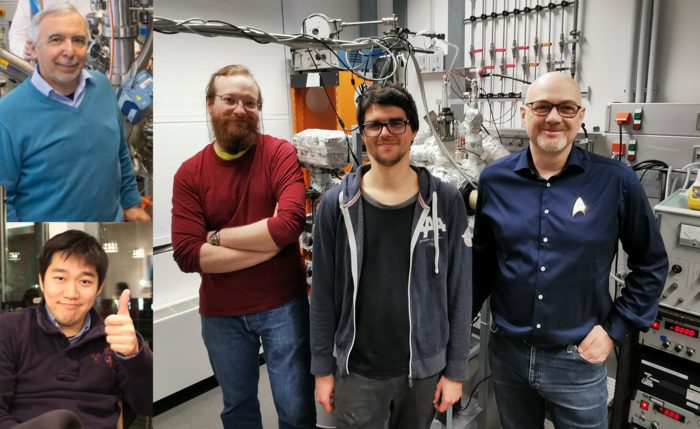Chaotic behavior is typically known from large systems: for example, from weather, from asteroids in space that are simultaneously attracted by several large celestial bodies, or from swinging pendulums that are coupled together. On the atomic scale, however, one does normally not encounter chaos – other effects predominate. Now, for the first time, scientists at TU Wien have been able to detect clear indications of chaos on the nanometer scale – in chemical reactions on tiny rhodium crystals. The results have been published in the journal Nature Communications.

Credit: TU Wien
Chaotic behavior is typically known from large systems: for example, from weather, from asteroids in space that are simultaneously attracted by several large celestial bodies, or from swinging pendulums that are coupled together. On the atomic scale, however, one does normally not encounter chaos – other effects predominate. Now, for the first time, scientists at TU Wien have been able to detect clear indications of chaos on the nanometer scale – in chemical reactions on tiny rhodium crystals. The results have been published in the journal Nature Communications.
From inactive to active – and back again
The chemical reaction studied is actually quite simple: with the help of a precious metal catalyst, oxygen reacts with hydrogen to form water, which is also the basic principle of a fuel cell. The reaction rate depends on external conditions (pressure, temperature). Under certain conditions, however, this reaction shows oscillating behavior, even though the external conditions are constant. “Similar to the way a pendulum swings from left to right and back again, the reaction rate oscillates between barely perceptible and high, and thus the catalytic system oscillates back and forth between inactive and active states” explains Prof. Günther Rupprechter from the Institute of Materials Chemistry at TU Wien.
A pendulum is a classic example of something predictable – if you disturb it a bit or set it in motion twice in slightly different ways, it behaves broadly the same. In this sense, it is the opposite of a chaotic system, where minimal differences in the initial conditions lead to strongly differing results in the long-term behavior. A prime example of this behavior are several pendulums connected by elastic bands.
Setting exactly the same initial conditions twice is impossible
“In principle, of course, laws of nature still determine exactly how pendulums behave,” says Prof. Yuri Suchorski (TU Wien). “If we could start such a coupled system of pendulums in exactly the same way twice, the pendulums would move exactly the same way both times.” But in practice, that’s impossible: you’ll never be able to perfectly recreate the same initial situation the second time as you did the first – and even a vanishingly small difference in the initial conditions will cause the system to behave completely different than the first time – this is the famous “butterfly effect”: small differences in the initial conditions lead to huge differences in the state at a later time.
Something very similar has now been observed during chemical oscillations on a rhodium nanocrystal: “The crystal consists of many different surface nanofacets, like a polished diamond, but much smaller, on the order of nanometers,” explain Maximilian Raab and Johannes Zeininger, who performed the experiments. “On each of these facets, the chemical reaction oscillates, but the reactions on neighboring facets are coupled.”
Switching – from order to chaos
The coupling behavior can now be controlled in a remarkable way – by changing the amount of hydrogen. Initially, one facet dominates and sets the pace like a pacemaker. All other facets join in and oscillate to the same beat. If one increases the hydrogen concentration, the situation becomes more complicated. Different facets oscillate with different frequencies – but still their behavior is periodic and well predictable. However, if one then increases the hydrogen concentration further, this order suddenly breaks down. Chaos wins, the oscillations become unpredictable, small differences in the initial situation lead to completely different oscillation patterns – a clear sign of chaos.
“This is remarkable because you wouldn’t really expect chaotic behavior in nanometer-sized structures,” says Yuri Suchorski. “The smaller the system, the greater the contribution of stochastic noise. In fact, the noise, which is something completely different from chaos, should dominate the behavior of the system: it is even more interesting that it was possible to “extract” indications of chaos”. A theoretical model was particularly useful, developed by Prof. Keita Tokuda (University Tsukuba).
Chaos research applied to nano-chemistry
“Research on chaos theory has been going on for decades, and it has already been successfully applied to chemical reactions in larger (macroscopic) systems, but our study is the first attempt to transfer the extensive knowledge from this field to the nanometer scale,” says Günther Rupprechter. “Small deviations in the symmetry of the crystal can determine whether the catalyst behaves in an ordered and predictable way or in a disordered and chaotic way. This is important for different chemical reactions – and perhaps even for biological systems.”
Journal
Nature Communications
DOI
10.5281/zenodo.5973929.
Method of Research
Experimental study
Subject of Research
Not applicable
Article Title
Emergence of chaos in a compartmentalized catalytic reaction nanosystem
Article Publication Date
10-Feb-2023




